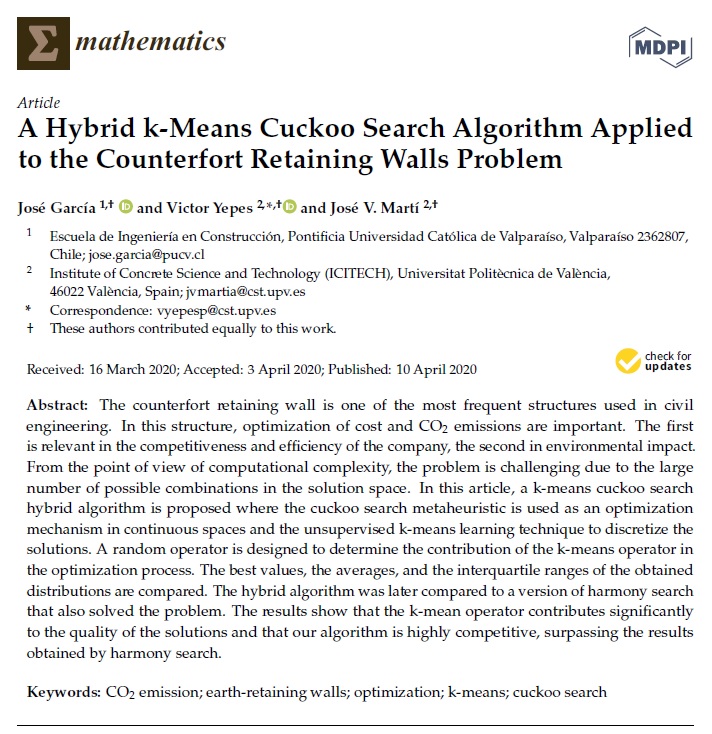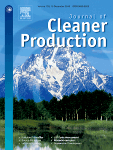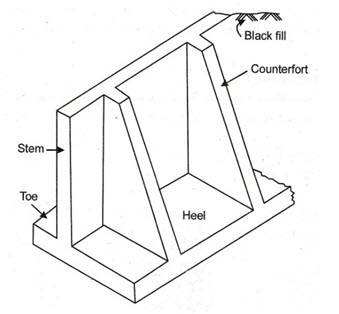 Acaban de publicarnos un artículo en la revista científica Applied Sciences (indexada en el JCR, Q2) un artículo que trata sobre el uso de distintas técnicas heurísticas para optimizar una pasarela de sección mixta hormigón-acero. El trabajo se enmarca dentro del proyecto de investigación DIMALIFE que dirijo como investigador principal en la Universitat Politècnica de València.
Acaban de publicarnos un artículo en la revista científica Applied Sciences (indexada en el JCR, Q2) un artículo que trata sobre el uso de distintas técnicas heurísticas para optimizar una pasarela de sección mixta hormigón-acero. El trabajo se enmarca dentro del proyecto de investigación DIMALIFE que dirijo como investigador principal en la Universitat Politècnica de València.
La importancia de la construcción en el consumo de recursos naturales está llevando a los profesionales del diseño estructural a crear diseños de estructuras más eficientes que reduzcan tanto las emisiones como la energía consumida. En este trabajo se presenta un proceso automatizado para obtener diseños óptimos energéticos de muros de contrafuertes. Se consideraron dos funciones objetivo para comparar la diferencia entre una optimización de costes y una optimización de energía incorporada. Para alcanzar el mejor diseño para cada criterio de optimización, se ajustaron los parámetros del algoritmo. Este estudio utilizó un algoritmo híbrido de optimización simulada para obtener los valores de la geometría, las resistencias del hormigón y las cantidades de hormigón y materiales. La relación entre todas las variables geométricas y la altura del muro se obtuvo ajustando las funciones lineales y parabólicas. Se encontró que la optimización de los costes y de la energía están vinculados. Una reducción de costes de 1 euro lleva asociada una reducción del consumo energético de 4,54 kWh. Para conseguir un diseño de baja energía, se recomienda reducir la distancia entre los contrafuertes con respecto a la optimización económica. Esta disminución permite reducir los refuerzos necesarios para resistir la flexión del alzado. La diferencia entre los resultados de las variables geométricas de la cimentación para los dos objetivos de optimización apenas revela variaciones entre ellos. Este trabajo proporciona a los técnicos algunas reglas prácticas de diseño óptimo. Además, compara los diseños obtenidos mediante estos dos objetivos de optimización con las recomendaciones de diseño tradicionales.
El artículo se ha publicado en abierto, y se puede descargar en el siguiente enlace: https://www.mdpi.com/2076-3417/11/4/1800
ABSTRACT:
The importance of construction in the consumption of natural resources is leading structural design professionals to create more efficient structure designs that reduce emissions as well as the energy consumed. This paper presents an automated process to obtain low embodied energy buttressed earth-retaining wall optimum designs. Two objective functions were considered to compare the difference between a cost optimization and an embodied energy optimization. To reach the best design for every optimization criterion, a tuning of the algorithm parameters was carried out. This study used a hybrid simulated optimization algorithm to obtain the values of the geometry, the concrete resistances, and the amounts of concrete and materials to obtain an optimum buttressed earth-retaining wall low embodied energy design. The relation between all the geometric variables and the wall height was obtained by adjusting the linear and parabolic functions. A relationship was found between the two optimization criteria, and it can be concluded that cost and energy optimization are linked. This allows us to state that a cost reduction of €1 has an associated energy consumption reduction of 4.54 kWh. To achieve a low embodied energy design, it is recommended to reduce the distance between buttresses with respect to economic optimization. This decrease allows a reduction in the reinforcing steel needed to resist stem bending. The difference between the results of the geometric variables of the foundation for the two-optimization objectives reveals hardly any variation between them. This work gives technicians some rules to get optimum cost and embodied energy design. Furthermore, it compares designs obtained through these two optimization objectives with traditional design recommendations.
Keywords:
Heuristic optimization; energy savings; sustainable construction; buttressed earth-retaining walls
Reference:
MARTÍNEZ-MUÑOZ, D.; MARTÍ, J.V.; GARCÍA, J.; YEPES, V. (2021). Embodied energy optimization of buttressed earth-retaining walls with hybrid simulated annealing. Applied Sciences, 11(4):1800. DOI:10.3390/app11041800




